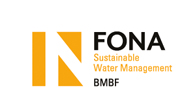In situ online biomonitoring of groundwater quality using freshwater amphipods exposed to organic fertilizer and rainfall events GroundCare | Publikation | Grundwasser
Vorschau
Nitrate levels originating from agricultural fields can reach groundwater concentrations far above the allowed threshold values. In this context we studied the effects of pig manure applied as fertilizer on a field with crop during several simulated rain events. The effects on groundwater crustaceans were monitored continuously using the Multispecies Freshwater Biomonitor© (MFB) adapted to groundwater conditions and for application in the field. Gammarus fossarum (Koch, 1835) and Niphargopsis casparyi (Pratz, 1866) served as indicator species in the biomonitor. Pig manure was applied on the test field, once spiked with sulfamethoxazole. Three rainfall events of different intensity and duration were simulated directly after the fertilization and the responses of the animals were quantitatively recorded in the online biomonitor for 24 h to 7 days. G. fossarumresponded within 24 h with decreasing spontaneous locomotor activity to elevated Nitrate levels being washed out from the surrounding soils. N. casparyiresponded in two experiments of 7 days’ duration with decreasing activity to elevated Nitrate levels in the 1st experiment and in the 2nd experiment to increased Nitrite and sulfamethoxazole levels showing decreased activity and 62.5% mortality. The three field experiments showed (1) successful operation of the online biomonitor MFB in situ, (2) G. fossarumsensitivity to Nitrate, (3) groundwater crustaceans’sensitivity to Nitrate, Nitrite and sulfamethoxazole. We recommend the use of subterraneous crustacean species for online biomonitoring of groundwater quality in agricultural areas as an effective measure to assess excess nutrients and pollutants aiming at subsequent reduction and compliance to the European groundwater directive.
Zum Produkt
Verweis: https://www.limco-int.com/wp-content/uploads/2020/03/TX-205_Galley-proof_17Mar20.pdf
Ansprechperson
Dr. Almut Gerhardt
T. +49 7531 9765096
M. info@limco-int.com


 Deutsch
Deutsch




